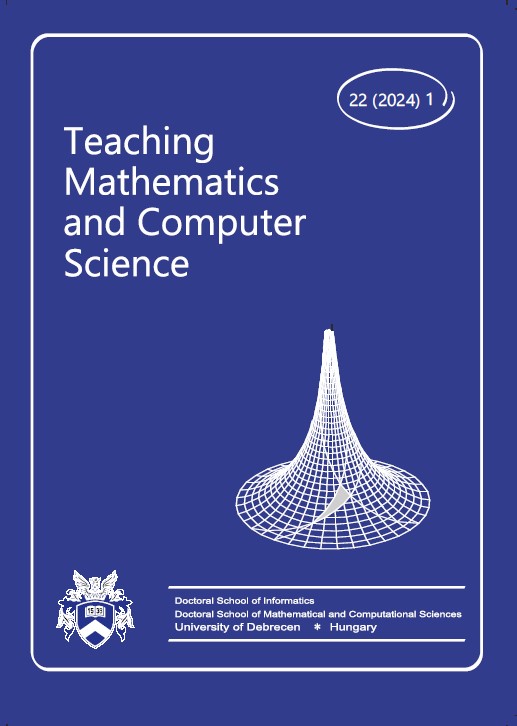Articles
Fostering engineering freshmen’s shifts of attention by using Matlab LiveScript for solving mathematical tasks
Published:
2024-06-12
Authors
View
Keywords
License
Copyright (c) 2024 Agnese Ilaria Telloni, Giovannina Albano

This work is licensed under a Creative Commons Attribution 4.0 International License.
How To Cite
Selected Style:
APA
Albano, G., & Telloni, A. I. (2024). Fostering engineering freshmen’s shifts of attention by using Matlab LiveScript for solving mathematical tasks. Teaching Mathematics and Computer Science, 22(1), 1-14. https://doi.org/10.5485/TMCS.2024.13299
Abstract
We designed an experimental path including a summative assessment phase, where engineering freshmen are involved in solving mathematical tasks by using Matlab LiveScripts. We analyzed the students’ answers to a questionnaire about their perceived impact of the use of Matlab on their way to solve mathematical tasks. The main result is that students show shifts of attention from computations to other aspects of problem solving, moving from an operational to a structural view of mathematics.
Subject Classification: 97U70, 97H60
References
- Albano, G., Donatiello, A., & Telloni, A. I. (2023). Towards relational thinking by Matlab LiveScript in linear algebra. In P. Drijvers, Cs. Csapodi, H. Palmér, K. Gosztonyi, & E. Kónya (Eds.), Proceedings of the Thirteenth Congress of the European Society for Research in Mathematics Education (CERME13)
- (pp. 2251–2258). Alfréd Rényi Institute of Mathematics and ERME.
- Buchberger, B. (1990). Should students learn integration rules? ACM SIGSAM Bulletin. 24 (1), 10–17. https://doi.org/10.1145/382276.1095228
- Cohen, L., Manion, L., & Morrison, K. (2018). Research methods in education (8th ed.). Routledge. https://doi.org/10.4324/9781315456539
- Connelly, F. M., & Clandinin, D. J. (1990). Stories of experience and narrative inquiry. Educational Researcher, 19 (5), 2–14. https://doi.org/10.2307/1176100
- Di Martino, P., & Zan, R. (2010). ’Me and maths’: Towards a definition of attitude grounded on students’ narratives. Journal of Mathematics Teacher Education, 13 (1), 27–48.
- Harel, G., Selden, A., & Selden, J. (2006). Advanced mathematical thinking. Some PME perspectives. In Á. Gutiérrez, & P. Boero (Eds.), Handbook of research on the psychology of mathematics education: Past, present and future (pp. 147–172). Sense Publishers.
- Jaworski, B., Robinson, C., Matthews, J., & Croft, A. C. (2012). Issues in teaching mathematics to engineering students to promote conceptual understanding: A study of the use of GeoGebra and inquiry-based tasks. The International Journal for Technology in Mathematics Education, 19 (4), 147–152.
- Kent, P., Bakker, A., Hoyles, C., & Noss, R. (2005a). Techno-mathematical literacies in the workplace. MSOR Connections, 5 (1), 5–7.
- Mason, J. (1998). Enabling teachers to be real teachers: Necessary levels of awareness and structure of attention. Journal of Mathematics Teacher Education, 1 (3), 243–267.
- Sfard, A. (1991). On the dual nature of mathematical conceptions: Reflections on processes and objects as different sides of the same coin. Educational Studies in Mathematics, 22, 1–36.
- Sfard A. (2008). Thinking as communicating: Human development, the growth of discourses, and mathematizing. Cambridge University Press.

 https://doi.org/10.5485/TMCS.2024.13299
https://doi.org/10.5485/TMCS.2024.13299






